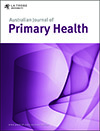Australian Journal of Primary Health
Volume 30
Number 3 2024
In older persons, the risk of developing frailty increases with age, and people with frailty experience higher morbidity, mortality and lower quality of life. However, frailty risk is not currently formally assessed and tracked in general practice in Australia. This pilot study demonstrates that frailty in Australians aged ≥75 years is identified frequently, and its identification and the subsequent management recommendations to reverse or reduce frailty risk, can be readily incorporated into the general practice workflow.
The Patient Centred Medical Home (PCMH) aims to deliver primary healthcare based on what matters most to patients and their families.This study addressed the lack of published research i examining implementation of this model of care in Aborignal Community Controlled Health Services. The PCMH was acceptable to Aboriginal and Torres Strait Islander patients and strengthened their relationships with health care providers. This provides an acceptable model of primary health care for other Aboriginal Community Controlled Health Services, with flexbility for tailoring to local context. .
Deprescribing of antidepressants is not routinely occurring in clinical practice, leading patients to seek help via other methods. Little is known about what role social media support groups play in a patient’s journey when ceasing antidepressant medication. This is one of the first studies to gain insight from antidepressant users who are also members of two Facebook groups providing support for antidepressant deprescribing. Lack of clinical knowledge by clinicians is a big driver for patients help seeking from their peers.
Limited studies have sought to implement and evaluate novel workforce approaches to reducing differential diabetes-related outcomes in the Aboriginal and Torres Strait Islander peoples populations. This review described the characteristics of the chronic disease management training programs and their effectiveness for Aboriginal Health Workers and Practitioners. Most included studies reported satisfaction with the training content, whereas some reported improved knowledge, confidence, and clinical and non-clinical skills of the participants. However, few studies reported knowledge transfer into clinical practice and client-related outcomes.
Patients with dental pain often seek treatment from general practitioners (GPs), even though the problem often requires dental treatment rather than antibiotics and/or pain relief medications. This study looked at GPs’ management of patients with dental problems, and identified barriers as to why patients would see a GP instead of a dentist. Understanding these reasons will help develop interventions to better educate patients in oral health, and provide better access to dental care to patients with oral conditions.
We have co-designed Health Journey Mapping tools and resources with First Nations patients and families and with First Nations and non-First Nations healthcare professionals to address current gaps in care. These pragmatic, strengths-based tools and resources enhance and incorporate cultural safety, continuous quality and improvement and comprehensive care and can be used collaboratively by healthcare consumers and professionals to assess and improve the quality, access, experiences and outcomes of care.





